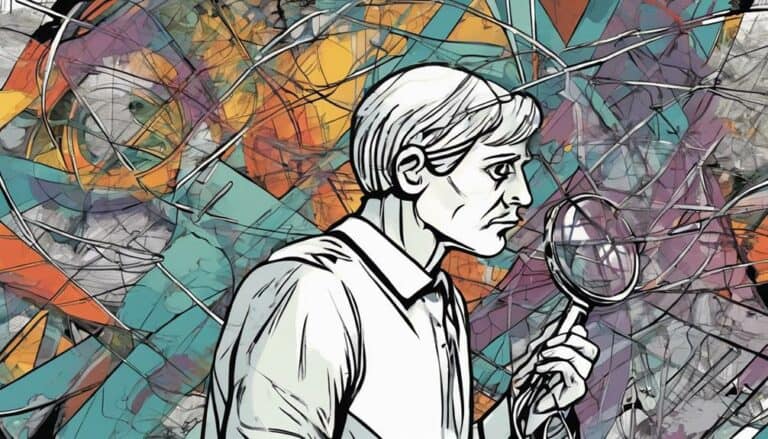To guarantee a thorough identification of issues in problem-solving, utilize various techniques like group discussions and data analysis for diverse viewpoints. Visual aids such as diagrams can help break down complex problems and identify patterns. Reflect on past experiences to learn and improve, and systematically test solutions to monitor effectiveness. Take time for introspection to understand personal biases and motivations. Employing these strategies will enhance your problem-solving skills effectively.
Key Takeaways
- Utilize group discussions for diverse perspectives.
- Enhance problem-solving with visual representations.
- Reflect on successful strategies and patterns.
- Employ systematic solution trials for testing.
- Allocate time for introspection to uncover biases.
Problem Identification Techniques
To effectively identify issues in problem-solving, employ a range of techniques to thoroughly analyze and discuss the problem, encouraging diverse perspectives for in-depth insight. In problem-solving, the first step is all-encompassing issue identification. Utilizing group discussions can help uncover various viewpoints that may lead to a more profound understanding of the problem. By creating an open space for dialogue, all team members can contribute their insights, aiding in the identification of patterns and underlying causes. Data analysis plays a vital role in this process, providing concrete evidence to support the identified issues.
When crafting a problem statement, make sure it's clear and concise to establish a common understanding among team members. Through these techniques, a more thorough examination of the problem can be achieved, leading to a more efficient problem-solving process. Remember, the key is to explore deeply into the problem, leaving no stone unturned to gain a full understanding of the issues at hand.
Visual Aids and Diagrams
Utilize visual aids and diagrams as strategic tools to enhance problem-solving by visually representing and dissecting the various components of the issue at hand. When dealing with complex issues, incorporating visual aids such as flowcharts or mind maps can assist in breaking down the problem into smaller, more manageable parts for thorough analysis. These diagrams offer a clear visual representation, making it easier to identify patterns, relationships, and connections that might not be immediately obvious. By drawing a diagram of the problem, you can effectively organize tasks and elements, enabling a more systematic approach to finding solutions. Consider the table below for a comparison of flowcharts and mind maps in aiding problem-solving:
| Aspect | Flowcharts | Mind Maps |
|---|---|---|
| Representation | Sequential and process-oriented | Non-linear and idea-centered |
| Focus | Detailed analysis of steps | Emphasizes relationships and associations |
| Use | Ideal for showing processes and decision points | Great for brainstorming and organizing thoughts |
Utilizing Past Experiences
Reflecting on past problem-solving experiences offers valuable insights into successful strategies and patterns that can be leveraged to navigate new challenges effectively. By analyzing the approaches taken in previous situations, you can identify patterns that led to successful outcomes.
Consider the lessons learned from past experiences to avoid making the same mistakes and to implement solutions more effectively in the future. Reflect on how different strategies were implemented and their effectiveness in addressing similar problems.
Drawing on personal or professional experiences can provide unique insights into the most effective approaches for specific issues. Evaluate the outcomes of past problem-solving efforts to determine what worked well and what could be improved upon in future scenarios.
Utilizing past experiences not only enhances your problem-solving skills but also increases the likelihood of achieving successful results in your current challenges.
Systematic Solution Trials
By systematically conducting trials on potential solutions, organizations can effectively evaluate their impact on identified issues.
Systematic solution trials are a critical part of the problem-solving process, allowing for a structured approach to testing various potential solutions.
Each solution is carefully implemented and monitored to assess its effectiveness in addressing the problem at hand. Through empirical testing and analysis, organizations can determine which solution is most suitable based on predefined criteria.
This approach enables comparisons between different solutions, aiding in making informed decisions on the best course of action to address the issue effectively.
Time for Introspection
Engaging in introspection allows you to explore your inner thoughts, feelings, and experiences related to the identified problem. By taking the time for self-examination, you can gain insights into your personal biases, assumptions, and perspectives that may be influencing how you perceive the issue at hand. Through introspection, you can understand your decision-making patterns and thought processes, shedding light on potential impacts on problem-solving strategies. Delving into introspection enables you to uncover hidden motivations, fears, or barriers that could hinder problem identification and resolution. It also offers a platform for a deeper exploration of your beliefs, values, and emotions, providing a thorough understanding of how these factors shape your problem-solving approach.
- Self-examination to gain insights into personal biases, assumptions, and perspectives
- Understanding decision-making patterns that impact problem-solving
- Uncovering hidden motivations, fears, or barriers affecting problem identification
- Exploring beliefs, values, and emotions influencing the perception of the problem
Conclusion
To guarantee thorough identification of issues in problem-solving, utilize techniques such as:
- Brainstorming
- Mind mapping
- Root cause analysis
Visual aids and diagrams can help clarify complex problems, while drawing from past experiences can provide valuable insights.
Conduct systematic solution trials to test different approaches and allow time for introspection to reflect on potential blind spots.
By utilizing these strategies, you can effectively navigate through challenges and find successful resolutions.

